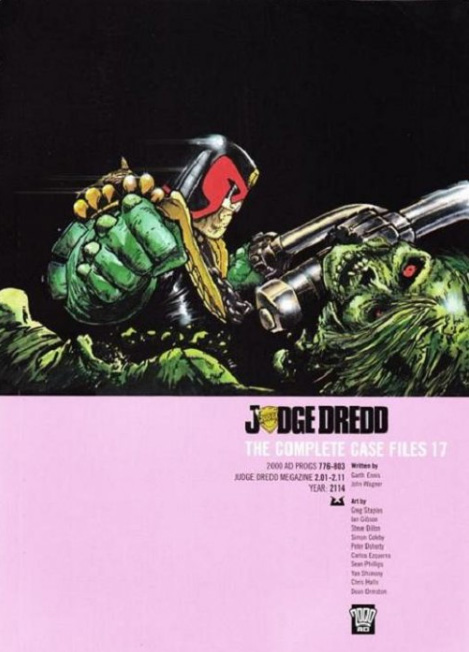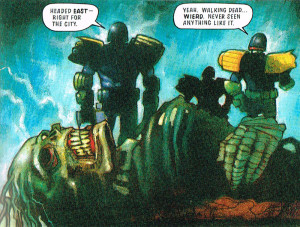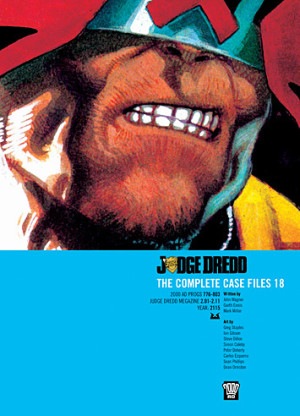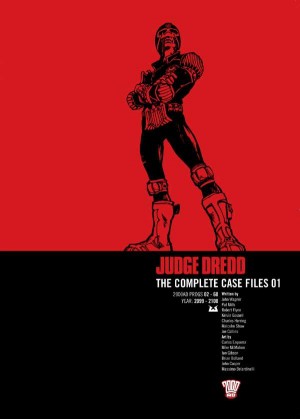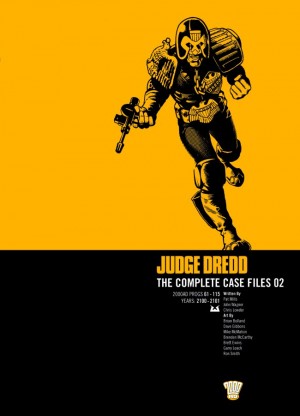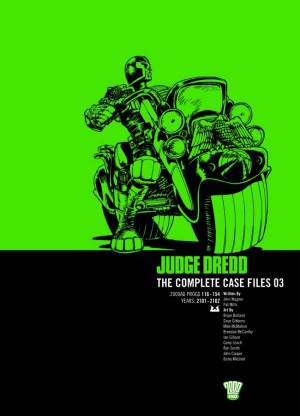Review by Roy Boyd
Case Files 17, written by Garth Ennis and John Wagner, contains seven stories: three of them before the epic ‘Judgement Day’, and three after.
The first three are all by Ennis. ‘Babes in Arms’ is a straightforward revenge tale helped by muscular Greg Staples artwork. ‘Almighty Dredd’ is a tongue-in-cheek tale of Dredd-worshippers who’re bumping off victims in his name, with appropriately cartoony Ian Gibson artwork. The last in our trio, ‘A Magic Place’, is a two-parter. The first manages tenderness and subtlety, largely because it’s drawn by Steve Dillon. The second part, sadly, is drawn by Simon Coleby, who is not a patch on Dillon, and the story suffers accordingly.
Then we’re into the twenty chapters of ‘Judgement Day’, Ennis’s first Dredd epic and the first story to be published simultaneously in both 2000 AD and the Judge Dredd Megazine. The latter had just been promoted to fortnightly publication, making a crossover more manageable. Wagner is co-credited for ‘plot’, but his contribution was apparently little more than suggesting the threat be zombies.
Evil magician Sabbat, who’s already wiped out one world, is set on destroying Earth. To this end, he taps into the energy flowing through the planet and uses it to reanimate the corpse of everyone who’s ever died. The zombies attack, and soon Dredd finds himself in Hondo City, tasked with leading assorted judges from surviving nations in an attack on Sabbat.
Unfortunately, as Ennis himself would later admit, his epic contained many already familiar elements. The most notable thing about the story is the inclusion of Johnny Alpha, Strontium Dog, after Dredd 2000AD‘s most popular strip. Dredd and Alpha had met before, but this time it was a proper team-up. However, this being Dredd’s world, and Ennis’s take on Dredd being that he’s the hardest bastard that ever lived, the mutant bounty hunter plays second fiddle to the Mega-City One lawman.
There is quite a lot to enjoy (like seeing Dredd and Alpha, both designed by Carlos Ezquerra, fighting side-by-side), but David Bishop, 2000 AD editor at the time, realised that it “created more problems than it resolved because we killed almost the entire supporting cast of Dredd. This was a blatant failure to learn the lessons from Judge Giant’s death in ‘Block Mania’”.
The artwork, as is often the case, is by a variety of artists: Ezquerra, Dean Ormston, Sean Philips and Peter Doherty. Much of it is very good, so it’s just a shame that the story isn’t.
The final three strips are a good indication of what one could expect from the Dredd material of the early to mid-1990s, at least in terms of artwork: one good, one bad, one indifferent. The first, ‘The Marshal’, is an Ennis story nicely painted by Sean Philips. The plot itself is strong, though Dredd comes across as heartless and mean, rather than the paragon of justice that Wagner writes so well. The penultimate story, ‘Texas City Sting’ is so good it even manages to overcome piss-poor artwork. The final story, which lacks even a title or a ‘Judge Dredd’ logo (though it does include a suggestive white space) has art by Ezquerra, so at least it looks like classic Dredd.
Ennis’s own assessment of ‘Judgement Day’? “On the whole, the thing fell flat”. After a fairly strong start, Ennis was starting to show signs of a writer that was stretched too thin.
